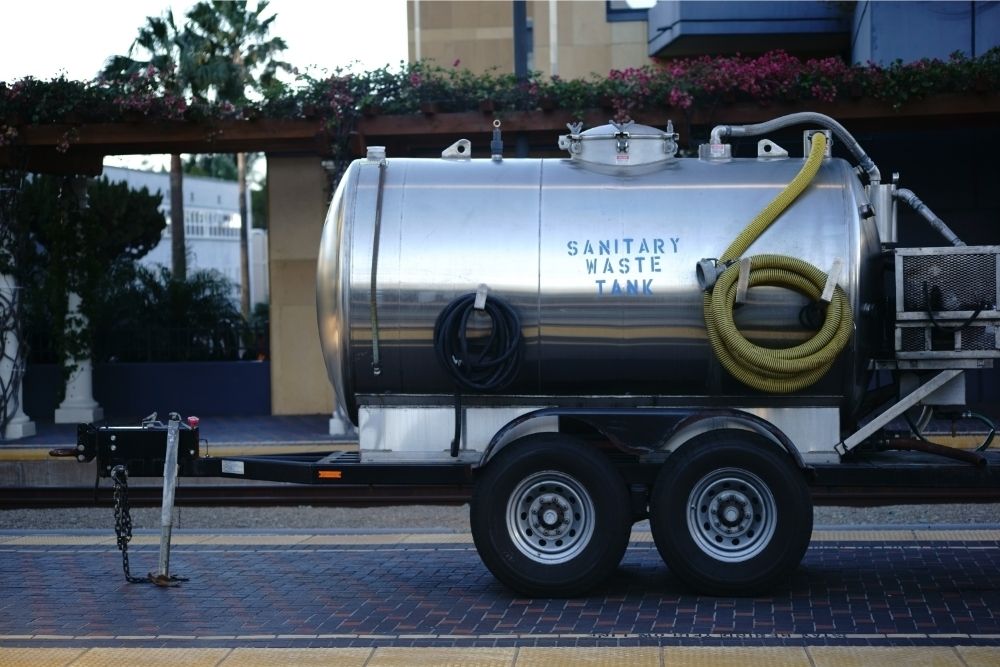Owning a boat can be a lot of fun, but there is also a fair amount of work needed to keep your vessel sea-worthy. If you have a boat large enough to have its own toilet, then one question you may have asked is how to empty the holding tank.
This tank holds all the wastewater from your onboard toilet, which makes emptying it an unpleasant, yet essential job.
A boat’s onboard toilet will often have some means of telling the owner when the holding tank is approaching maximum capacity.
Even if it isn’t full, it is good practice to completely drain your boat before packing it away for winter to prevent waste from freezing and potentially damaging your vessel.

Most people will simply take their boat to a dump station, but if this isn’t an option for you then it is possible to drain your onboard wastewater at home.
Some may be tempted to release the contents of their tank straight into the water while out boating but this is not recommended.
Not only is doing this illegal in some areas, but human waste can also have serious negative repercussions for aquatic wildlife. This article will take you through three different methods you can use to drain your boat’s holding tank at home.
Where To Dump Your Wastewater
Before we can show you how to pump out the holding tank in your boat, it is important to know where you will be dumping the wastewater that comes out of it.
Whatever you do never put wastewater straight down the toilet, as it will likely lead to clogs and other drainage issues further down the line.
Whether you have a house connected to the main sewer or a private septic tank you should be able to find a PVC cleanout pipe in your yard or near your home.
This is a pipe between your house and the sewer entrance or septic tank, that you can often find by looking for a plastic pipe with a screw-on cap somewhere in your garden.
This is the easiest place to dispose of the contents of your boat’s holding tank as all you will need to do is unscrew the cap and pour it in.
If you have a septic tank but can’t find the cleanout pipe, then you can use the access lid to dump your wastewater straight into the tank.
When doing this there are a few things you will need to watch out for. Firstly, locate the baffle in your tank and always dump your waste on the side that is furthest from your house to prevent solid matter from clogging up your house’s drainage.
Also, when dumping into a septic tank, always make sure you aren’t using any harmful treatment chemicals in your boat’s tank. This is to prevent killing the good bacteria in your septic tank which help with breaking down solid waste.
Only use the access port that is closest to your house and check if you are legally allowed to do so if it isn’t located on your land.
Always take the proper precautions when opening the access port to your septic tank. Cover your face with a mask and avoid breathing in too many of the gases that come out.
Septic tanks contain a lot of methane which can be potentially fatal if you inhale too much. As well as a face covering make sure you have a good set of rubber gloves that you don’t plan to use for anything else.
Using A Bucket
If your boat isn’t particularly big, then you can use drain your holding tank into a five-gallon bucket. You can buy one of these from most DIY shops or online. To do this you will definitely need a good set of gloves as well as a face mask or full-on ventilator.
Place the bucket beneath the opening to the tank and open the valve very slowly to prevent splashing or over-filling. Drain the tank until the bucket is mostly full, but leave space at the top to prevent any wastewater sloshing over the edge.
Carry the bucket to your home’s cleanout pipe or the access port to your septic tank and carefully pour the contents away.
This method is only viable for boats with smaller tanks, as otherwise, you will need to repeat this process and ferry multiple buckets of wastewater to the cleanout or access port you are using.
After you are done, thoroughly disinfect the bucket and store it somewhere safe for the next time you need to drain your holding tank.
Using A Macerator Pump

For larger tanks that are too big to empty with buckets, you will have to use a sewage hose to dump your wastewater straight from the boat into a cleanout or access port. When doing this it can often help to use a macerator pump.
These devices use stainless steel blades to chop up solid waste into smaller pieces creating a slurry that is fired out of the pump at high pressure. As well as buying a macerator pump, you will need some other equipment to empty your boat’s holding tank using this method.
Before you can start you should buy a length of garden hose (that shouldn’t be used for anything else), an ordinary hose adaptor, and another CDFJ adaptor.
Link the pump to the outlet valve on your boat’s holding tank using the ordinary adaptor, and then use the CDFJ one to connect the other end of the pump to the length of the garden hose. Place the other end of this hose into the cleanout or access port you are dumping into.
Once you have all this set up, open the valve on your boat’s tank before turning on the pump. While it works, pour clean water down your vessel’s toilet to flush the system through and give your pump an easier time handling the solid matter.
Keep pouring water down until the waste coming out of the hose runs clear, this means your tank is completely empty and you can turn the pump off.
Emptying The Tank Without A Macerator
If you can’t afford to buy a macerator pump, and the tank on your boat is too big to use a bucket, then you can simply empty your holding tank directly into a cleanout or access port. This final method is faster and more convenient, but it can also be bad for your home’s drainage system if not done properly.
The only thing you will need is a length of sewage hose long enough to reach from your boat to the pipe you will be dumping into.
You should open the outlet valve on your boat’s tank slowly when using this method for several reasons. If the wastewater is dumped too fast it may flow back up the cleanout pipe which can cause clogs in your household drainage.
When dumping straight into an access port, it is best to do so slowly so you cause minimal disruption to the surface layer of scum. This is to prevent disrupting the natural cultures of bacteria in your septic tank that are responsible for breaking down waste.
After you have been draining for a while, flush your boat’s system with clean water to remove any residual waste and clean out your hose.
Conclusion
All of the above methods will allow you to dispose of the wastewater in your boat’s holding tank without going to a dump station. Always properly disinfect and clean any equipment that you use for this job before storing it away for next time.
As long as you take the proper precautions, emptying your holding tank won’t take much time, and you should be able to avoid spilling any sewage on yourself in the process.
Frequently Asked Questions
Is It Legal to Empty My Boat’s Holding Tank At Home?
If a cleanout is located on your land, then you should be allowed to use it for disposing of wastewater from your boat’s holding tank.
That said, you should always check the local laws on dumping sewage or other forms of effluent first, especially when dumping into the main sewer line.
If you don’t own a septic tank and aren’t allowed to dump into a cleanout that leads to the sewers, then you will have to take your boat to a dump station in order to dispose of the contents of your holding tank.
Can I Empty My Boat’s Tank Directly Into The Water?
No, the reason many boats in the USA are required to have holding tanks is to prevent owners from dumping their sewage into lakes or the ocean. Feces contains lots of different types of bacteria that can be extremely harmful to marine life.
This means that dumping your boat holding tank straight into the water could have disastrous effects on local wildlife and should therefore be avoided at all costs.
Either use one of the methods in this article to dispose of your waste at home, or take your boat to a local dump station.
